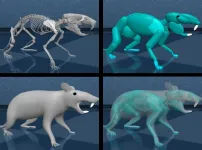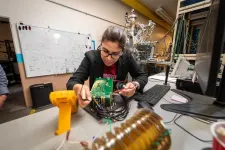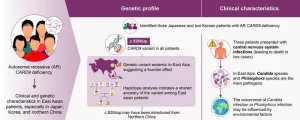(Press-News.org) When college athletes are evaluated for a possible concussion, the diagnosis is based on an athletic trainer or team physician’s assessment of three things: the player’s symptoms, physical balance and cognitive skills.
Research published today suggests that almost half of athletes who are ultimately diagnosed with a concussion will test normally on the recommended cognitive-skills test.
“If you don’t do well on the cognitive exam, it suggests you have a concussion. But many people who are concussed do fine on the exam,” said Dr. Kimberly Harmon, the study’s lead author. She is a professor of family medicine and section head of sports medicine at the University of Washington School of Medicine.
The study findings appear in JAMA Network Open.
Harmon said her sideline experiences as a team physician for the UW Huskies caused her to wonder how to accurately interpret the cognitive-screening portion of the Sport Concussion Assessment Tool (SCAT). Introduced in 2004 by the Concussion in Sport Group, the SCAT (now in its fifth iteration, SCAT5) was intended to standardize the gathering of information from athletes with a potential head injury.
The SCAT first prompts an athlete about whether they are experiencing any of 22 symptoms such as headache, nausea or blurred vision, and symptom severity. Then the tool tests the athlete’s cognition in several ways.
First come questions of orientation. (What day is it? What month is it?) Then a test of immediate memory, in which a list of 10 words is read aloud to the athlete, who is asked to restate the list. This sequence is repeated three times. Then the athlete’s concentration is tested by having to repeat short sequences of numbers in reverse order. Then comes a prescribed evaluation of the athlete’s balance, after which the athlete is again asked to recall the 10 words from the first list.
In Harmon’s experience as a team physician, she saw that “some people were concussed and they did well on the recall tests. Some people weren’t concussed and they didn’t do well. So I thought we should study it,” she said.
The study involved 92 NCAA Division I athletes who sustained a concussion between July 13, 2020, and Dec. 31, 2022, and who had a concussion evaluation within 48 hours. The investigators also recruited 92 of the concussed players’ teammates as matched control subjects, each of whom was given the SCAT5 screening within two weeks of the incident concussion.
All athletes in the study had previously completed NCAA-required baseline concussion screenings. The investigators found no significant differences in baseline scores between the athletes with and without concussion.
Harmon and colleagues analyzed the study participants’ SCAT5 responses and found that the word-recall tests had little predictive value for concussion. In fact, almost half (45%) of the concussed athletes performed at or above their baseline cognitive-test results, the researchers reported.
Instead, the study showed that the most accurate predictor of concussion were the athletes’ responses to questions about their symptoms.
“If you get hit in the head and go to the sideline and say, ‘I have a headache. I’m dizzy. I don’t feel right,’ I can say with pretty good assurance that you have a concussion,” Harmon said. “I don’t need to do any testing. The problem is that some athletes don’t want to come out. They don’t report their symptoms or may not recognize their symptoms. So then you need an objective, accurate test to tell you whether you can safely put the athlete back on the field. We don’t have that right now.”
During in-game evaluations for a concussion, team trainers and physicians must quickly synthesize the available evidence and make their best clinical judgment about a player’s health. The responsibility for a safety-first decision, though, also lies in part with the athletes, the study’s authors wrote:
“Although an increase in symptoms is highly suggestive of concussion, this relies on accurate reporting by the athlete who may not report symptoms because of a desire to return to play, a fear of letting teammates down, minimizing the seriousness of concussion, difficulty discerning symptoms, a delay in symptom development, or other reasons.”
“We are still short of the holy grail, which is an objective test for concussion,” Harmon said. “For now, this study shows how important it is for athletes to disclose their symptoms.”
The study was funded in part by the Jack and Luellen Cherneski and the Chisholm Foundation.
END
Cognitive test is poor predictor of athletes’ concussion
Part of the NCAA’s standardized concussion evaluation fails to distinguish athletes who were actually injured, a study shows.
2024-06-11
ELSE PRESS RELEASES FROM THIS DATE:
Buck researchers explore how the immune system goes awry during space travel and the implications for human aging on earth
2024-06-11
As long as humans have been traveling into space, astronauts have experienced significant health effects from the extreme conditions of space flight, notably the reduction of gravity.
Two Buck scientists led a team that has revealed for the first time how the lack of gravity affects the cells of the immune system at single cell resolution. As co-senior authors, along with Christopher E. Mason, PhD of Weill Cornell Medical College, Associate Professor David Furman, PhD and Associate Professor Daniel Winer, MD, published in the ...
Social determinants of health linked with youth-onset prediabetes
2024-06-11
Food insecurity, low household income and not having private health insurance are associated with higher rates of prediabetes in adolescents, independent of race and ethnicity, according to a new JAMA Network Open study by University of Pittsburgh and UPMC researchers.
The findings suggest that screening for social determinants of health — the non-medical factors that influence a person's health and risk of disease — may help identify youth at risk of prediabetes, which could ultimately improve early interventions that prevent progression to type 2 diabetes.
“This study underscores the importance ...
Harvard, Google DeepMind researchers create realistic virtual rodent
2024-06-11
The agility with which humans and animals move is an evolutionary marvel that no robot has yet been able to closely emulate. To help probe the mystery of how brains control movement, Harvard neuroscientists have created a virtual rat with an artificial brain that can move around just like a real rodent.
Bence Ölveczky, professor in the Department of Organismic and Evolutionary Biology, led a group of researchers who collaborated with scientists at Google’s DeepMind AI lab to build a biomechanically realistic digital model of a rat. Using high-resolution data recorded from ...
Scientists unlock secrets of how the third form of life makes energy
2024-06-11
Scientists unlock secrets of how the third form of life makes energy.
An international scientific team has redefined our understanding of archaea, a microbial ancestor to humans from two billion years ago, by showing how they use hydrogen gas.
The findings, published today in Cell, explain how these tiny lifeforms make energy by consuming and producing hydrogen. This simple but dependable strategy has allowed them to thrive in some of Earth’s most hostile environments for billions of years.
The paper, led by Monash University Biomedicine Discovery Institute scientists, including ...
Would astronauts’ kidneys survive a roundtrip to Mars?
2024-06-11
The structure and function of the kidneys is altered by space flight, with galactic radiation causing permanent damage that would jeopardise any mission to Mars, according to a new study led by researchers from UCL.
The study, published in Nature Communications, is the largest analysis of kidney health in space flight to date and includes the first health dataset for commercial astronauts. It is published as part of a Nature special collection of papers on space and health.
Researchers have known that space flight causes certain health issues since the 1970s, in the ...
Depressive symptoms may hasten memory decline in older people
2024-06-11
Depressive symptoms are linked to subsequent memory decline in older people, while poorer memory is also linked to an increase in depressive symptoms later on, according to a new study led by researchers at UCL and Brighton and Sussex Medical School.
The study, published in JAMA Network Open, looked at 16 years of longitudinal data from 8,268 adults in England with an average age of 64.
The researchers concluded that depression and memory were closely interrelated, with both seeming to affect each other.
Senior author Dr Dorina Cadar, of the UCL Department of Behavioural Science & Health and Brighton and Sussex Medical School, said: “It is ...
New technique could help build quantum computers of the future
2024-06-11
Quantum computers have the potential to solve complex problems in human health, drug discovery, and artificial intelligence millions of times faster than some of the world’s fastest supercomputers. A network of quantum computers could advance these discoveries even faster. But before that can happen, the computer industry will need a reliable way to string together billions of qubits – or quantum bits – with atomic precision.
Connecting qubits, however, has been challenging for the research community. Some methods form qubits by placing ...
Trash-sorting robot mimics complex human sense of touch
2024-06-11
WASHINGTON, June 11, 2024 – Today’s intelligent robots can accurately recognize many objects through vision and touch. Tactile information, obtained through sensors, along with machine learning algorithms, enables robots to identify objects previously handled.
However, sensing is often confused when presented with objects similar in size and shape, or objects unknown to the robot. Other factors restrictive to robot perception include background noise and the same type of object with different shapes and sizes.
In Applied Physics Reviews, by AIP Publishing, researchers from Tsinghua University worked to break through the difficulties ...
Shedding light on the origin of a genetic variant underlying fungal infections
2024-06-11
Researchers from Japan uncover the genetic diversity and regional patterns of CARD9 deficiency in patients susceptible to fungal diseases
Tokyo, Japan – Fungal infections pose life-threatening risks, especially when vital organs or the central nervous system are affected. Individuals harboring variants in the CARD9 gene are particularly susceptible to invasive fungal infections, given that the protein coded by this gene serves as a critical regulator of the immune system. A recent discovery ...
Humanitarian organizations showed flexibility and grit during COVID supply chain disruptions: study
2024-06-11
When the COVID-19 pandemic hit, it sent shock waves across global supply chains. But manufacturers and other businesses weren’t the only ones hit hard: local and international aid organizations, tasked with providing humanitarian assistance during times of crisis, suddenly had a major crisis of their own. How would they get the supplies they needed to carry out their crucial work?
According to a new study by the UBC Sauder School of Business, the organizations showed remarkable nimbleness and ingenuity — and while the pandemic was an unusual event, their approaches can provide powerful insights ...
LAST 30 PRESS RELEASES:
The Ceramic Society of Japan’s Oxoate Ceramics Research Association launches new international book project
Heart-brain connection: international study reveals the role of the vagus nerve in keeping the heart young
Researchers identify Rb1 as a predictive biomarker for a new therapeutic strategy in some breast cancers
Survey reveals ethical gaps slowing AI adoption in pediatric surgery
Stimulant ADHD medications work differently than thought
AI overestimates how smart people are, according to HSE economists
HSE researchers create genome-wide map of quadruplexes
Scientists boost cell "powerhouses" to burn more calories
Automatic label checking: The missing step in making reliable medical AI
Low daily alcohol intake linked to 50% heightened mouth cancer risk in India
American Meteorological Society announces Rick Spinrad as 2026 President-Elect
Biomass-based carbon capture spotlighted in newly released global climate webinar recording
Illuminating invisible nano pollutants: advanced bioimaging tracks the full journey of emerging nanoscale contaminants in living systems
How does age affect recovery from spinal cord injury?
Novel AI tool offers prognosis for patients with head and neck cancer
Fathers’ microplastic exposure tied to their children’s metabolic problems
Research validates laboratory model for studying high-grade serous ovarian cancer
SIR 2026 delivers transformative breakthroughs in minimally invasive medicine to improve patient care
Stem Cell Reports most downloaded papers of 2025 highlight the breadth and impact of stem cell research
Oxford-led study estimates NHS spends around 3% of its primary and secondary care budget on the health impacts of heat and cold in England
A researcher’s long quest leads to a smart composite breakthrough
Urban wild bees act as “microbial sensors” of city health.
New study finds where you live affects recovery after a hip fracture
Forecasting the impact of fully automated vehicle adoption on US road traffic injuries
Alcohol-related hospitalizations from 2016 to 2022
Semaglutide and hospitalizations in patients with obesity and established cardiovascular disease
Researchers ‘listen in’ to embryo-mother interactions during implantation using a culture system replicating the womb lining
How changing your diet could help save the world
How to make AI truly scalable and reliable for real-time traffic assignment?
Beyond fragmented markets: A new framework for efficient and stable ride-pooling
[Press-News.org] Cognitive test is poor predictor of athletes’ concussionPart of the NCAA’s standardized concussion evaluation fails to distinguish athletes who were actually injured, a study shows.




